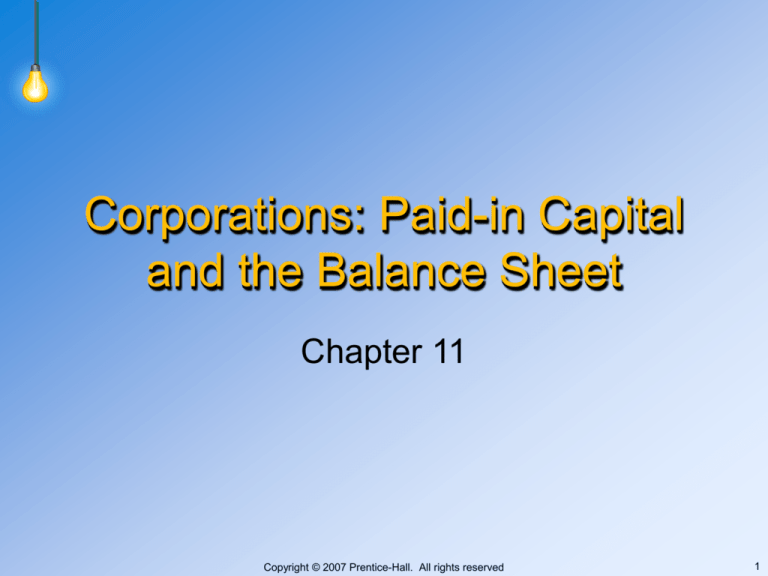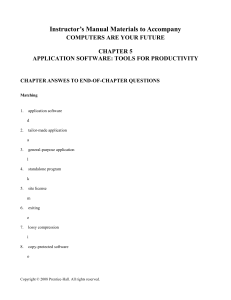
Corporations: Paid-in Capital
and the Balance Sheet
Chapter 11
Copyright © 2007 Prentice-Hall. All rights reserved
1
Objective 1
Identify the characteristics of a
corporation
Copyright © 2007 Prentice-Hall. All rights reserved
2
Characteristics
• Separate legal entity from the owners
(stockholders) - formed under laws of a
particular state
• Continuous life and transferability of ownership ownership divided into shares of stock that can
be transferred to another
• No mutual agency - owners can not act as
agents of the business
• Limited liability of stockholders - stockholders
are not responsible for the debts of the
corporation
Copyright © 2007 Prentice-Hall. All rights reserved
3
Characteristics
• Separation of ownership and management board of directors appoints officers to manage
the business
• Corporate taxation - corporation pays franchise
tax, federal and state income taxes
• Government regulation
Copyright © 2007 Prentice-Hall. All rights reserved
4
Organizing a Corporation
• Incorporators obtain charter from the state
• Charter authorizes corporation to
– Issue stock
– Conduct business in accordance with state
law and the corporation’s bylaws
Copyright © 2007 Prentice-Hall. All rights reserved
5
Organizing a Corporation
• Stockholders elect board of directors
• Board
– Sets policy
– Appoints officers
– Elects a chairperson
Copyright © 2007 Prentice-Hall. All rights reserved
6
Capital Stock
• Corporate ownership - evidenced by a
stock certificate
• Total number of shares authorized is
limited by charter
Copyright © 2007 Prentice-Hall. All rights reserved
7
Stockholders’ Equity
• Two components:
– Paid-in capital
– Retained earnings
Copyright © 2007 Prentice-Hall. All rights reserved
8
Stockholders’ Equity
Sole-proprietor
Owner, Capital
Investments
Withdrawals Net Income
Separate investments by
owners (stockholders) and
the earnings of the company
into 2 sections of
stockholders’ equity
Corporation
Paid in Capital
Investments
Retained Earnings
Dividends
Copyright © 2007 Prentice-Hall. All rights reserved
Net Income
9
Stockholders’ Equity
Issue stock
GENERAL JOURNAL
DATE
DESCRIPTION
REF
Cash
Common Stock
Copyright © 2007 Prentice-Hall. All rights reserved
DEBIT
CREDIT
XXXX
XXXX
10
Stockholders’ Equity
Close income summary
GENERAL JOURNAL
DATE
DESCRIPTION
REF
Income Summary
Retained Earnings
Copyright © 2007 Prentice-Hall. All rights reserved
DEBIT
CREDIT
XXXX
XXXX
11
Stockholders’ Rights
• Four basic rights
– Vote
– Dividends
– Liquidation
– Preemption
Copyright © 2007 Prentice-Hall. All rights reserved
12
Classes of Stock
• Common stock - most basic form of capital
stock
• Preferred stock - owners have certain
advantages over common stockholders
– Receive dividends before common
– Upon liquidation, receive assets before
common
– Right to vote sometimes withheld
Copyright © 2007 Prentice-Hall. All rights reserved
13
Classes of Stock
• Par value
• No-par value
Copyright © 2007 Prentice-Hall. All rights reserved
14
Objective 2
Record the issuance of stock
Copyright © 2007 Prentice-Hall. All rights reserved
15
Issuing Stock
Paid-in Capital
Cash
Amount
Amount
Par
received
received
over par
Common Stock
Paid-in Capital in Excess of Par
Copyright © 2007 Prentice-Hall. All rights reserved
16
Issuing Stock
On June 2, Mustang Properties issued 1,000
shares of $1 par common stock for cash of $1
per share
GENERAL JOURNAL
DATE
Jun
DESCRIPTION
REF
2 Cash
Common Stock
(1,000 shares x $1)
Copyright © 2007 Prentice-Hall. All rights reserved
DEBIT
CREDIT
1,000
1,000
17
E11-14
GENERAL JOURNAL
DATE
DESCRIPTION
REF
Jun 19 Cash
Common Stock
Paid-in Capital in Excess of
Par-common
DEBIT
CREDIT
8,000
1,000
7,000
Just the par value goes to the
Common Stock account.
Everything else goes to the Paid
in Capital in Excess
Copyright © 2007 Prentice-Hall. All rights reserved
18
E11-14
GENERAL JOURNAL
DATE
DESCRIPTION
REF
Jun 19 Cash
Common Stock
Paid-in Capital in Excess of
Par-common
Stated-common
DEBIT
CREDIT
8,000
1,000
7,000
What if this stock was no par
stock with a stated value of $1?
How would the entry be
different?
Copyright © 2007 Prentice-Hall. All rights reserved
19
E11-14
GENERAL JOURNAL
DATE
DESCRIPTION
REF
Jun 19 Cash
Common Stock
Paid-in Capital in Excess of
Par-common
DEBIT
CREDIT
8,000
1,000
8,000
7,000
What if this stock was true no par stock? How
would the entry be different?
Note: All of the proceeds from the sale of stock
becomes part of legal capital
Copyright © 2007 Prentice-Hall. All rights reserved
20
E11-14
GENERAL JOURNAL
DATE
Jul
DESCRIPTION
REF
3 Cash
Preferred Stock
DEBIT
CREDIT
15,000
15,000
This is no par stock, so the
entire proceeds are credited
to the Preferred Stock
account
Copyright © 2007 Prentice-Hall. All rights reserved
21
E11-14
GENERAL JOURNAL
DATE
Jul
DESCRIPTION
REF
11 Equipment
Common Stock
Paid-in Capital in Excess of
Par – Common
DEBIT
CREDIT
20,000
3,000
17,000
When you issue stock for a
noncash asset, debit the
asset for its fair market
value
Copyright © 2007 Prentice-Hall. All rights reserved
22
E11-14 (2)
Paid-in Capital
Preferred Stock
15,000
Common Stock
1,000
3,000
4,000
Paid-in Capital
in Excess
of Par, Common
7,000
17,000
24,000
Total Paid-in Capital = $43,000
Copyright © 2007 Prentice-Hall. All rights reserved
23
Objective 3
Prepare the stockholders’ equity
section of a corporation balance sheet
Copyright © 2007 Prentice-Hall. All rights reserved
24
E11-17
GENERAL JOURNAL
DATE
Aug
DESCRIPTION
REF
6 Cash
Common Stock
Paid in Capital in Excess of
Par, Common
DEBIT
13,000
500
12,500
12 Cash
Preferred Stock
20,000
14 Land
Common Stock
Paid in Capital in Excess of
Par, Common
26,000
Copyright © 2007 Prentice-Hall. All rights reserved
CREDIT
20,000
1,000
25,000
25
E11-17
GENERAL JOURNAL
DATE
DESCRIPTION
REF
Aug 31 Income summary
Retained earnings
Copyright © 2007 Prentice-Hall. All rights reserved
DEBIT
CREDIT
40,000
40,000
26
Notice how the stock is
E11-17
described in each line…..par
value, number of shares
Stockholders’ Equity
authorized and then number
Paid-in capital:
of shares issued
Preferred stock, $3, no-par, 100,000
authorized, 300 issued………………. $20,000
Common stock, $1 par, 500,000
authorized, 1,500 issued…………….
1,500
Paid-in capital in excess of par
common……………………………… 37,500
Total paid-in capital…………………… $59,000
Retained earnings………………………. 40,000
Total stockholders’ equity…………… $99,000
Copyright © 2007 Prentice-Hall. All rights reserved
27
Objective 4
Account for cash dividends
Copyright © 2007 Prentice-Hall. All rights reserved
28
Dividend Dates
• Declaration date
• Date of record
• Payment date
Copyright © 2007 Prentice-Hall. All rights reserved
29
Declaring and Paying Dividends
S11-8
The declaration of a cash
dividend decreases retained
4% x $100,000
$4,000
earnings and creates
a
current liability
x 50,000
25,000
Preferred stock:
Common: $0.50
Total dividends
$29,000
GENERAL JOURNAL
DATE
DESCRIPTION
REF
2008
Dec 15 Retained earnings
Dividends payable
Copyright © 2007 Prentice-Hall. All rights reserved
DEBIT
CREDIT
29,000
29,000
30
Declaring and Paying Dividends
S11-8
GENERAL JOURNAL
DATE
DESCRIPTION
REF
2009
Jan 4 Dividends payable
Cash
Copyright © 2007 Prentice-Hall. All rights reserved
DEBIT
CREDIT
29,000
29,000
31
Preferred: Per Share Dividend
• Stated as percentage of par value or as
specified amount
• How much does one share of 3%
preferred stock with a $50 par value
receive when dividends are declared and
paid? $1.50
Copyright © 2007 Prentice-Hall. All rights reserved
32
Preferred: Per Share Dividend
• Stated as percentage of par value or as
specified amount
• How much does one share of $4 preferred
stock with a $50 par value receives when
dividends are declared and paid? $4
Copyright © 2007 Prentice-Hall. All rights reserved
33
Cumulative & Noncumulative
Preferred Stock
• Cumulative preferred stock - accumulates
dividends each year until the dividends are
paid
Assume that preferred stock
– Dividends in arrears - is
dividends
or not
cumulativepassed
if it is not
specifically designated as
paid
– Dividends in arrears - noncumulative
not a liability
• Noncumulative preferred stock – dividends
not paid do not accumulated from one
year to the next
Copyright © 2007 Prentice-Hall. All rights reserved
34
S11-9
1. Preferred stock is cumulative because it is not
specifically designated as noncumulative
2. Preferred dividend per year:
5% x $10 x 4,000 = $2,000
2005: Preferred stockholders get $2,000
Common stockholders get the rest, $13,000
Copyright © 2007 Prentice-Hall. All rights reserved
35
S11-9
3. 2006: Dividends in arrears = $2,000
2007: Dividends in arrears = $4,000
2008:
Preferred stockholders get $6,000
(2 years in arrears and current year)
Common stockholders get the rest, $9,000
What if the preferred stock
was noncumulative? How
would the $15,000 be
divided? Preferred, $2,000
and Common, $13,000
Copyright © 2007 Prentice-Hall. All rights reserved
36
E11-21
1. Preferred stock is cumulative because it is not
specifically designated as noncumulative
2. Preferred dividend per year:
8% x $10 x 20,000 = $16,000
2007: Preferred stockholders get $10,000
(Note: Dividends in arrears of $6,000)
Common stockholders get nothing
Copyright © 2007 Prentice-Hall. All rights reserved
37
E11-21
3. 2008:
Preferred stockholders get:
Dividends in arrears
Current year’s
Total to preferred stockholders
$6,000
16,000
$22,000
Common stockholders get the rest, $28,000
Copyright © 2007 Prentice-Hall. All rights reserved
38
Objective 5
Use different stock values in
decision making
Copyright © 2007 Prentice-Hall. All rights reserved
39
Different Values of Stock
• Market value - current selling price
• Book value - equity a stockholder has in
net assets of the corporation
Copyright © 2007 Prentice-Hall. All rights reserved
40
Book Value per Share
Book value common =
(Stockholders’ equity – Preferred Equity)
÷ Number of shares outstanding
Copyright © 2007 Prentice-Hall. All rights reserved
41
E11-23
Book value per share on common:
Total stockholders’ equity
Attributable to preferred:
$50 par x 1,000 shares
Attributable to common
Per share:
$227,000 / 5,000 = $45.40
Copyright © 2007 Prentice-Hall. All rights reserved
$277,000
(50,000)
$227,000
42
E11-24
Book value per share on common:
Total stockholders’ equity
Attributable to preferred:
Dividends in arrears ($50,000
x 6% x 3 years)
$50 par x 1,000 shares
Attributable to common
Per share:
$218,000 / 5,000 = $43.60
Copyright © 2007 Prentice-Hall. All rights reserved
$277,000
(9,000)
(50,000)
$218,000
43
Objective 6
Evaluate return on assets and
return on stockholders’ equity
Copyright © 2007 Prentice-Hall. All rights reserved
44
Rate of Return on Total Assets
E11-25
Net Income + Interest Expense
Average Total Assets
$18,000,000 + 2,400,000
($326,000,000 + 317,000,000) / 2
$20,400,000
$321,500,000
.063
Copyright © 2007 Prentice-Hall. All rights reserved
45
Rate of Return on Common
Stockholders’ Equity - E11-25
Net Income – Preferred Dividends
Average Common Stockholders’ Equity
$18,000,000 – ($2x 100,000)
($184,000,000 + $176,000,000) / 2
$17,800,000
$180,000,000
.099
Copyright © 2007 Prentice-Hall. All rights reserved
46
Objective 7
Account for the income tax of a
corporation
Copyright © 2007 Prentice-Hall. All rights reserved
47
Income Taxes
Income tax expense =
Revenues and expenses
Income before income tax (frommay
income
statement)
be reported in
× Income tax rate
different periods for
income statement and
tax return purposes.
Income tax payable =
Alternative
Taxable income (from the tax return
fileddepreciation
with IRS)
methods may be used
× Income tax rate
for book and tax
purposes
Copyright © 2007 Prentice-Hall. All rights reserved
48
Income Taxes
• Deferred tax liability = difference between
income tax expense and income tax payable for
any one year
Copyright © 2007 Prentice-Hall. All rights reserved
49
E11-26
GENERAL JOURNAL
DATE
DESCRIPTION
REF
(in millions)
Income Tax Expense
(400 x 37.5%)
Income Tax Payable
(344 x 37.5%)
Deferred Tax Liability
Copyright © 2007 Prentice-Hall. All rights reserved
DEBIT
CREDIT
150
129
21
50
E11-26
INCOME STATEMENT:
Income before income tax
Income tax expense
Net income
BALANCE SHEET:
Current liabilities:
Income tax payable
Long-term liabilities:
Deferred tax liability
Copyright © 2007 Prentice-Hall. All rights reserved
$400
150
$ 250
$ 129
$ 21
51
End of Chapter 11
Copyright © 2007 Prentice-Hall. All rights reserved
52









